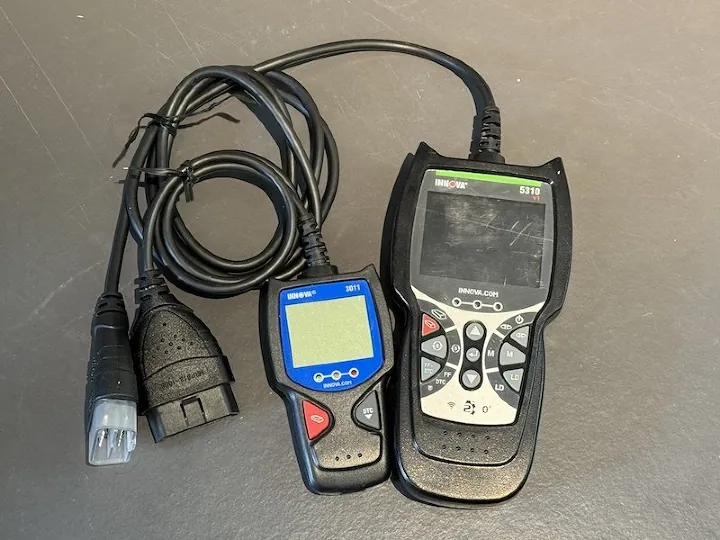Stuff We Use: OBD-II Code Readers

On our never-ending quest to improve this place by listening to feedback from the B&B, we are taking a new tack with these product posts, choosing instead to focus on items we have actually used or purchased with our own meagre income. After all, if we’re giving you the truth about cars, we ought to give you the truth about car accessories.
Just about everyone who toils at this publication have worked on a vehicle equipped with the so-called OBD-II diagnostic system. Given the tendencies of our readership, it is a reasonable to imagine many of our readers have done this as well. Having a handheld OBD-II code reader in yer box of tools can be a lifesaver – or at least douse that infernal check engine light.
Or at least douse it for half an hour, right? For those not in the know OBD stands for On-Board Diagnostics and permits a vehicle owner or mechanic access to the status of the various vehicle sub-systems when they have the right computerized tool at hand. In 1996, with computers having become ubiquitous in most new cars, the OBD-II specification was made mandatory for all passenger cars and gasoline-powered light trucks with a weight rating less than 8,500 lb. (except California where it was required on all gasoline-powered vehicles up to 14,000 pounds so long as they had California Emissions).
Rules have changed over the years, eliminating the weight restrictions and eventually becoming a fixture across just about everything on the road. Code readers which can communicate with the system are able to help diagnose triggers for certain warning lights, evaluate the health of an electrical system, and reset maintenance reminders (though the latter can often be done simply through a new car’s infotainment system these days).
For yer next pub trivia night, know that most error codes start with a P (for powertrain) though there are C (chassis) and B (body) codes as well. The second through fifth characters of a code are usually numbers and help determine what specific problem is being complained about by the car. Like VINs, the first two or three digits are universal for categories like fuel metering or vehicle speed control, for example.
Two code readers, both found on eBay and both from a brand called Innova, have found their way into my toolbox – likely through a moment’s inattention or forgetfulness. In any event, the smaller of these two readers, the Innova 3011, is a small unit about the size of a pack of smokes and only has two buttons plus a digital readout screen with decent resolution. Selling for about 50 bucks, this tool can only tell you why a check engine light is on and scan for emissions related problems, two categories of issues which are common to many drivers.
In fact, such information is probably enough for most DIYers to suss out what’s wrong with their car instead of blindly throwing parts at a problem. Even people who can’t or aren’t interested in fixing their own car can benefit from a code reader since simply knowing the intelligent questions to ask prior to visiting yer mechanic can save a lot of money in the long run. Sure, the tech can run their own diagnostics but showing up with codes in hand helps one be a much more informed customer.
The other code reader in my arsenal, the Innova 5310, is about twice the size and has far more functions. For starters, it can read problems with an ABS system, which is great if all that’s wrong with the thing is a cheap wheel speed sensor. It can also perform tests on a car’s battery and alternator, reset maintenance alerts, and deal with SRS airbag codes. It’s a great piece of kit, one used more often than I’d like to admit.
Most cars have the proprietary port into which these readers are plugged located somewhere under the dash near the driver’s knees. And it’s worth stating that clearing a code emphatically does not fix the underlying problem – the light is probably going to come back on eventually. Some cars throw a check engine light for a loose fuel filler cap, something my father has been dealing with on his 2013 Lincoln MKX for ages. That machine has an early version of Ford’s capless filler system, instead using a spring-loaded flap to seal the filler neck. Problem is, that spring has gotten weak over time and regularly doesn’t cause that metal flap to fully close. Nothing’s wrong with the car at all – but I still reset the check engine light every time he visits so mom doesn’t complain about it as frequently. Of course, a couple of fill ups causes the flap to not close properly and the light is on again. Repeat ad nauseum.
As planned, this series of posts will continue to focus on items we’ve actually used and bought with our own money. We hope you found this one helpful.
[Images: Author]
Become a TTAC insider. Get the latest news, features, TTAC takes, and everything else that gets to the truth about cars first by subscribing to our newsletter.

Matthew buys, sells, fixes, & races cars. As a human index of auto & auction knowledge, he is fond of making money and offering loud opinions.
More by Matthew Guy
Latest Car Reviews
Read moreLatest Product Reviews
Read moreRecent Comments
- Kwi65728132 Here's a maintenance tip that no one ever seems to recommend: "Read the damn Owner's Manual and have your car serviced according to the recommended service intervals listed in the service information!" Also, "Sealed For Life" means for the life of the lubricating fluid... Which isn't very long if you believe that horse manure, get it changed at least every 30-50k miles.
- Dave M. The "first ins" already got theirs. I'm not opposed to owning one, but it's got to have a magical 400+ mile range, take no more than 30 mins to fully charge (with an improved infrastructure), and be reasonably priced (under $50k max). We're not there yet, but I bet we will be within 10 years....
- 28-Cars-Later I'm shocked. Who could have seen this coming?
- Cprescott This shouldn't be a problem. We've thrown tens of billions of taxpayer dollars to build all of these golf cart charging stations. Aren't eight of them enough?
- ToolGuy It is 62 miles from Weekapaug to Woonsocket, and I give my heartiest congratulations to the state of Rhode Island for providing the charging infrastructure to cover that distance.




































Comments
Join the conversation